
International Journal of Spatial Data Infrastructures Research
Scope & Guideline
Fostering Collaboration in Spatial Data Management
Introduction
Aims and Scopes
- Development and Management of Spatial Data Infrastructures:
Research related to the design, implementation, and management of spatial data infrastructures, including best practices and case studies from various regions. - Integration of Geospatial Technologies:
Exploring the integration of various geospatial technologies, such as GIS, remote sensing, and spatial databases, in enhancing the effectiveness of SDIs. - Policy and Governance Issues in SDIs:
Examination of the policies, legal frameworks, and governance structures that influence the development and utilization of spatial data infrastructures. - User Engagement and Community Participation:
Studies focusing on how communities and end-users engage with spatial data infrastructures, including participatory approaches and user-centered design. - Innovative Applications of Spatial Data:
Research on novel applications of spatial data in diverse fields, such as urban planning, environmental monitoring, and disaster management.
Trending and Emerging
- Smart Cities and Urban Analytics:
An increasing number of studies are exploring the role of spatial data infrastructures in the development of smart cities, focusing on urban analytics and data-driven decision-making. - Spatial Data Sharing and Interoperability:
There is a growing emphasis on the importance of data sharing and interoperability among different SDI systems, highlighting collaborative frameworks and standards. - Impact of Big Data on Spatial Analysis:
Research is increasingly addressing the implications of big data for spatial analysis, including how to manage and analyze vast datasets within SDIs. - Climate Change and Environmental Sustainability:
Emerging studies are focusing on the application of spatial data infrastructures in addressing climate change and promoting environmental sustainability, reflecting global priorities. - Citizen Science and Volunteered Geographic Information (VGI):
There is a trend towards investigating the contributions of citizen science and VGI in the context of spatial data infrastructures, emphasizing community engagement and democratization of data.
Declining or Waning
- Traditional Mapping Techniques:
Research focusing solely on traditional mapping methods is becoming less prominent as the field shifts towards more advanced geospatial technologies and methodologies. - Static Data Models:
There is a noticeable decline in studies emphasizing static data models, as the focus is increasingly on dynamic and real-time data integration within SDIs. - Localized Case Studies:
The journal has seen fewer localized case studies, indicating a shift towards broader, comparative analyses and global perspectives on spatial data infrastructures. - Historical Analysis of SDI Development:
Research concentrating on the historical evolution of spatial data infrastructures is becoming less common, as contemporary and future-oriented studies gain more traction.
Similar Journals

Revue Internationale de Geomatique
Connecting Disciplines Through Geospatial InnovationRevue Internationale de Geomatique (ISSN: 1260-5875, E-ISSN: 2116-7060) is a prestigious journal published by TECH SCIENCE PRESS, dedicated to advancing the field of geomatics. This journal serves as a vital platform for disseminating significant research findings, cutting-edge methodologies, and innovative applications within the realm of spatial data and technology. With an emphasis on interdisciplinary studies, it fosters collaboration among researchers, professionals, and students across various domains, including environmental science, urban planning, and geographic information systems (GIS). Although not an open-access journal, Revue Internationale de Geomatique maintains a rigorous peer-review process ensuring the publication of high-quality articles that contribute to the evolving landscape of geomatics. Given its relevance and commitment to scholarly excellence, this journal is a crucial resource for advancing knowledge and practices in the ever-growing field of spatial information science.

Journal of Spatial Information Science
Connecting Ideas, Mapping FuturesThe Journal of Spatial Information Science is a premier open-access journal published by the University of Maine, dedicated to advancing research in the interdisciplinary fields of spatial information science, geography, and computer science. With an ISSN of 1948-660X, this journal has established itself as a significant contributor to the academic community since its inception in 2010, achieving notable rankings as evidenced by its classification in the Q2 quartile across multiple categories, including Computers in Earth Sciences and Geography. The journal offers a platform for innovative research, fostering collaboration and knowledge dissemination among researchers and practitioners. Its impact is further underscored by its Scopus rankings, placing it in the top percentiles across critical disciplines. With Open Access options available, the Journal of Spatial Information Science ensures that high-quality research is accessible to a broader audience, promoting the ongoing development of the field through thoughtful and rigorous academic inquiry.
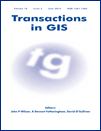
Transactions in GIS
Advancing Geographic Insights for a Better TomorrowTransactions in GIS is a premier academic journal published by WILEY, dedicated to advancing the field of Geographic Information Science (GIS). With an ISSN of 1361-1682 and an E-ISSN of 1467-9671, this journal has continually contributed valuable insights since its inception in 1996, transforming the landscape of GIS research and application. Covering a broad scope within Earth and Planetary Sciences, it holds a notable Q2 ranking and stands in the 74th percentile among its peers as per Scopus rankings. The journal serves as a critical platform for researchers, professionals, and students who seek to disseminate and engage with innovative GIS methodologies, applications, and theoretical advancements. With a commitment to quality and rigor, Transactions in GIS remains a vital resource for those at the forefront of geographic research and analysis.
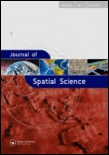
Journal of Spatial Science
Transforming Understanding of Our Spatial WorldThe Journal of Spatial Science, published by Taylor & Francis Ltd, serves as a prominent platform for the dissemination of research in the interdisciplinary fields of geography, atmospheric science, and energy. With an ISSN of 1449-8596 and an E-ISSN of 1836-5655, this journal has established itself as a vital resource since its inception in 2004, boasting an impressive convergence period extending to 2024. Recognized in the Q3 quartile for Atmospheric Science and Energy (miscellaneous), and achieving a Q2 classification in Geography, Planning and Development in 2023, the journal not only reflects the evolving complexities of spatial science but also underscores its increasing relevance in addressing contemporary global challenges. The journal holds a commendable position in Scopus rankings, with notable placements in various categories, further highlighting its academic significance. Researchers, professionals, and students are encouraged to engage with the rich content offered, as the Journal of Spatial Science remains committed to advancing knowledge and fostering discussions pertinent to spatial analysis and its applications.

Boletim de Ciencias Geodesicas
Pioneering Discoveries in the Dynamic World of GeodesyBoletim de Ciências Geodésicas is an esteemed academic journal published by the Universidade Federal do Paraná within its Centro Politécnico. Focused on the dynamic field of Earth and Planetary Sciences, this Open Access journal has been a pivotal resource since 1997, fostering the dissemination of critical research and innovative methodologies. With an impact factor indicative of its relevance in the discipline, Boletim de Ciências Geodésicas ranks in the Q3 quartile for Earth and Planetary Sciences as of 2023, showcasing its commitment to quality scholarship in a competitive field. Researchers and students alike will benefit from access to cutting-edge findings, given its broad scope that encompasses various aspects of geodesy and related sciences. The journal's convergence of research from 2005 to 2024 ensures that it remains at the forefront of emerging trends and fundamental developments in the discipline, further enhancing its esteemed reputation in the academic community.

Spatial Information Research
Advancing the frontiers of spatial data science.Spatial Information Research, published by SPRINGER SINGAPORE PTE LTD, is a prominent journal committed to advancing the interdisciplinary field of spatial information science. With an ISSN of 2366-3286 and an E-ISSN of 2366-3294, this journal serves as a crucial platform for disseminating research findings from 2016 to 2024, focusing on applications in Artificial Intelligence, Computer Science Applications, and Geography, among others. Ranking in the Q2 and Q3 quartiles across various categories, it showcases impactful research that informs geographic planning, environmental sciences, and computational methodologies. The journal's rigorous peer-review process ensures high-quality contributions that offer insights for both academic scholars and industry professionals. While retaining exclusive access options, Spatial Information Research is a vital resource for researchers eager to explore the complexities of spatial data and its applications in real-world scenarios.

International Journal of Engineering and Geosciences
Championing open access to groundbreaking research.The International Journal of Engineering and Geosciences, with ISSN 2548-0960, is a premier academic journal published by Selcuk University Press, specializing in the interrelated fields of engineering and geosciences. Established as an Open Access resource in 2016, the journal aims to enhance the dissemination of research, fostering collaboration and innovation within the scientific community. Based in Turkey, this journal serves as a vital platform for researchers and professionals to share their findings and contribute to the advancement of knowledge in environmental science and related disciplines. With an impressive Q2 category ranking in the field of Environmental Science (miscellaneous) for 2023, it ranks #81 out of 219 in Scopus, placing it in the 63rd percentile. The journal not only acknowledges transformative research trends from 2019 to 2024 but also emphasizes the importance of sustainability and environmental stewardship in engineering practices, making it an indispensable resource for students, researchers, and professionals passionate about the intersection of these disciplines.
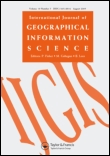
INTERNATIONAL JOURNAL OF GEOGRAPHICAL INFORMATION SCIENCE
Unveiling Insights Through Geospatial InnovationThe INTERNATIONAL JOURNAL OF GEOGRAPHICAL INFORMATION SCIENCE, published by TAYLOR & FRANCIS LTD, stands as a premier platform in the fields of geography, planning and development, and information systems. With an impressive impact factor and recognized as a Q1 journal in 2023 across multiple categories, this esteemed publication underscores its significant role in advancing knowledge and application in geographical information sciences. Since its inception in 1997, the journal has provided vital insights and research findings, appealing to a diverse audience of researchers, professionals, and students dedicated to exploring the complexities of spatial data and its implications. Notably, it boasts exceptional Scopus rankings, positioning it among the top journals in its fields. While the journal does not offer open access, it remains a crucial resource for those looking to deepen their understanding and engagement with contemporary geographic and information science issues.
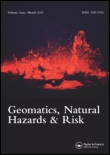
Geomatics Natural Hazards & Risk
Championing Open Access Research in Earth SciencesGeomatics Natural Hazards & Risk, published by TAYLOR & FRANCIS LTD, is a premier open-access journal that has been at the forefront of interdisciplinary research since 2010, addressing critical issues related to natural hazards and environmental risk management. With an impressive impact factor and ranking in the Q1 quartile in both Earth and Planetary Sciences and Environmental Science categories, this journal serves as a vital platform for researchers, professionals, and students dedicated to advancing knowledge in these fields. The journal's commitment to open access since 2016 ensures that its high-quality research is readily available to a global audience, fostering collaboration and innovation. Located in the United Kingdom, Geomatics Natural Hazards & Risk encompasses a broad scope of studies including geospatial technologies, risk assessment methodologies, and the societal impacts of natural disasters, making it an essential resource for anyone involved in the investigation and mitigation of natural hazards.
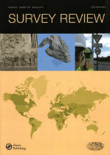
SURVEY REVIEW
Advancing Knowledge Across Engineering and Earth SciencesSURVEY REVIEW is a distinguished journal published by Taylor & Francis Ltd, focusing on a diverse range of disciplines including Civil and Structural Engineering, Computers in Earth Sciences, and Earth and Planetary Sciences. With an ISSN of 0039-6265 and an E-ISSN of 1752-2706, this journal has been a vital resource for scholarly communication since its inception in 1963. Positioned within the Q2 and Q3 quartile categories according to the latest rankings, it is recognized for its significant contributions to advancing knowledge in multiple fields, specifically holding a rank of 64/159 in Earth and Planetary Sciences and 32/73 in Computers in Earth Sciences. Researchers, professionals, and students benefit from its critical insights into complex engineering and scientific challenges. Although SURVEY REVIEW is not open access, it remains a highly cited journal, making it an essential avenue for disseminating pivotal findings that impact both academia and industry practices.